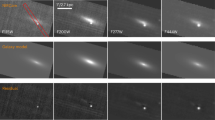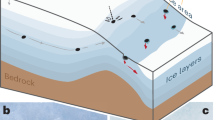Abstract
Gamma-ray bursts (GRBs) are known to come in two duration classes1, separated at ∼2 s. Long-duration bursts originate from star-forming regions in galaxies2, have accompanying supernovae when these are near enough to observe and are probably caused by massive-star collapsars3. Recent observations4,5,6,7,8,9,10 show that short-duration bursts originate in regions within their host galaxies that have lower star-formation rates, consistent with binary neutron star or neutron star–black hole mergers11,12. Moreover, although their hosts are predominantly nearby galaxies, no supernovae have been so far associated with short-duration GRBs. Here we report that the bright, nearby GRB 060614 does not fit into either class. Its ∼102-s duration groups it with long-duration GRBs, while its temporal lag and peak luminosity fall entirely within the short-duration GRB subclass. Moreover, very deep optical observations exclude an accompanying supernova13,14,15, similar to short-duration GRBs. This combination of a long-duration event without an accompanying supernova poses a challenge to both the collapsar and the merging-neutron-star interpretations and opens the door to a new GRB classification scheme that straddles both long- and short-duration bursts.
This is a preview of subscription content, access via your institution
Access options
Subscribe to this journal
Receive 51 print issues and online access
$199.00 per year
only $3.90 per issue
Buy this article
- Purchase on Springer Link
- Instant access to full article PDF
Prices may be subject to local taxes which are calculated during checkout


Similar content being viewed by others
References
Kouveliotou, C. et al. Identification of two classes of gamma-ray bursts. Astrophys. J. 413, L101–L104 (1993)
Fruchter, A. et al. Long γ-ray bursts and core-collapse supernovae have different environments. Nature 441, 463–468 (2006)
Woosley, S. E. Gamma-ray bursts from stellar mass accretion disks around black holes. Astrophys. J. 405, 273–277 (1993)
Gehrels, N. et al. A short gamma-ray burst apparently associated with an elliptical galaxy at z = 0.225. Nature 437, 851–854 (2005)
Fox, D. B. et al. The afterglow of GRB 050709 and the nature of the short-hard gamma-ray bursts. Nature 437, 845–851 (2005)
Villasenor, J. S. et al. Discovery of the short gamma-ray burst GRB 050709. Nature 437, 855–878 (2005)
Hjorth, J. et al. The optical afterglow of the short gamma-ray burst GRB 050709. Nature 437, 859–861 (2005)
Barthelmy, S. D. et al. An origin for short gamma-ray bursts unassociated with current star formation. Nature 438, 994–996 (2005)
Berger, E. et al. The afterglow and elliptical host galaxy of the short gamma-ray burst GRB 050724. Nature 438, 988–990 (2005)
Bloom, J. S. et al. Closing in on a short-hard burst progenitor: constraints from early-time optical imaging and spectroscopy of a possible host galaxy of GRB 050509b. Astrophys. J. 638, 354–368 (2006)
Paczynski, B. Gamma-ray bursters at cosmological distances. Astrophys. J. 308, L43–L46 (1986)
Eichler, D., Livio, M., Piran, T. & Schramm, D. N. Nucleosynthesis, neutrino bursts and gamma-rays from coalescing neutron stars. Nature 340, 126–127 (1989)
Fynbo, J. P. U. et al. No supernovae associated with two long-duration γ-ray bursts. Nature doi: 10.1038/nature05375 (this issue); preprint at (astro-ph 0608313) (2006)
Gal-Yam, A. et al. A novel explosive process is required for the γ-ray burst GRB 060614. Nature doi: 10.1038/nature05373 (this issue); preprint at 〈http://arxiv.org/astro-ph/0608257〉 (2006)
Della Valle, M. et al. An enigmatic long-lasting γ-ray burst not accompanied by a bright supernova. Nature doi: 10.1038/nature05374 (this issue); preprint at 〈http://arxiv.org/astro-ph/0608322〉 (2006)
Gehrels, N. et al. The Swift gamma ray burst mission. Astrophys. J. 611, 1005–1020 (2004)
Price, P. A., Berger, E. & Fox, D. B. GRB 060614: redshift. GCN Circ. 5275, (2006)
Schaefer, B. E. & Xiao, L. GRB060614 is at high redshift, so no new class of gamma-ray bursts is required. Preprint at 〈http://arxiv.org/astro-ph/0608441〉 (2006)
Cobb, B. E. et al. Could GRB 060614 and its presumed host galaxy be a chance superposition?. Astrophys. J. 651, L85–L88 (2006)
Kaneko, Y. et al. Prompt and afterglow emission properties of gamma-ray bursts with spectroscopically identified supernovae. Astrophys. J. (in the press); preprint at 〈http://arxiv.org/astro-ph/0607110〉 (2006)
Norris, J. P. & Bonnell, J. T. Short gamma-ray bursts with extended emission. Astrophys. J. 643, 266–275 (2006)
Mazets, E. P. et al. Konus Catalog of Short GRBs 〈http://www.ioffe.ru/LEA/shortGRBs/Catalog/〉. Preprint at 〈http://arxiv.org/astro-ph/astro-ph0209219 〉 (Ioffe Physico-Technical Institute, Laboratory for Experimental Astrophysics, 2002)
Norris, J. P. Implications of the lag-luminosity relationship for unified gamma-ray burst paradigms. Astrophys. J. 579, 386–403 (2002)
Donaghy, T. Q. et al. HETE-2 localizations and observations of four short gamma-ray bursts: GRBs 010326B, 040802, 051211 and 060121. Preprint at 〈http://arxiv.org/astro-ph/0605570〉 (2006)
Zhang, W., Woosley, S. E. & MacFadyen, A. I. Numerical simulations of relativistic jets in collapsars. Astrophys. J. 586, 356–371 (2003)
Woosley, S. E. & Bloom, J. S. The supernova–gamma-ray burst connection. Annu. Rev. Astron. Astrophys. 44, 507–561 (2006)
Narayan, R., Piran, T. & Kumar, P. Accretion models of gamma-ray bursts. Astrophys. J. 557, 949–957 (2001)
Faber, J. A. et al. Relativistic binary merger simulations and short gamma-ray bursts. Astrophys. J. 641, L93–L96 (2006)
Golenetskii, S. et al. Konus-Wind observation of GRB 060614. GCN Circ. 5264, (2006)
Vanderspek, R. et al. Observations of the gamma ray burst GRB 030329: Evidence for a soft underlying component. Astrophys. J. 617, 1251–1257 (2004)
Author information
Authors and Affiliations
Corresponding author
Ethics declarations
Competing interests
Reprints and permissions information is available at www.nature.com/reprints. The authors declare no competing financial interests.
Rights and permissions
About this article
Cite this article
Gehrels, N., Norris, J., Barthelmy, S. et al. A new γ-ray burst classification scheme from GRB 060614. Nature 444, 1044–1046 (2006). https://doi.org/10.1038/nature05376
Received:
Accepted:
Issue Date:
DOI: https://doi.org/10.1038/nature05376
This article is cited by
-
A lanthanide-rich kilonova in the aftermath of a long gamma-ray burst
Nature (2024)
-
A long-duration gamma-ray burst with a peculiar origin
Nature (2022)
-
Strange flashes linked to stars merging rather than dying
Nature (2022)
-
The case for a minute-long merger-driven gamma-ray burst from fast-cooling synchrotron emission
Nature Astronomy (2022)
-
Testing the Amati and Yonetoku correlations for short gamma-ray bursts
Astrophysics and Space Science (2022)
Comments
By submitting a comment you agree to abide by our Terms and Community Guidelines. If you find something abusive or that does not comply with our terms or guidelines please flag it as inappropriate.



